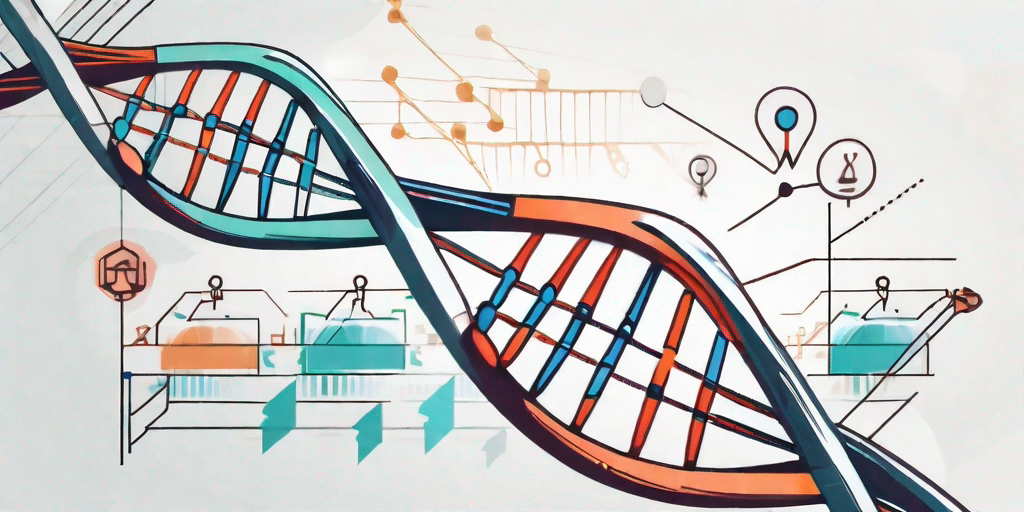Unlocking Bioinformatics Understanding with a Strategy Speaker

Unlocking Bioinformatics Understanding with a Strategy Speaker
Bioinformatics is a field of study that combines biology, computer science, and information technology to analyze and interpret biological data. It plays a crucial role in areas such as genomics, proteomics, and drug discovery. However, understanding and applying bioinformatics can be a daunting task, especially for those without a strong background in this field.
Understanding the Basics of Bioinformatics
If you're new to bioinformatics, it's essential to start with the basics. Bioinformatics involves the use of computational tools and algorithms to analyze large datasets generated from experiments such as DNA sequencing. It helps researchers understand biological processes and make sense of complex biological data.
Learning bioinformatics requires a solid understanding of molecular biology, genetics, statistics, and programming. It involves acquiring knowledge in areas such as sequence alignment, gene expression analysis, and protein structure prediction.
Bioinformatics has revolutionized the field of genomics by enabling researchers to analyze vast amounts of genetic information. With the advent of high-throughput sequencing technologies, it has become possible to generate massive datasets in a short period. These datasets contain valuable information about the genetic makeup of organisms, their evolutionary history, and their interactions with the environment.
One of the fundamental concepts in bioinformatics is sequence alignment. This process involves comparing two or more DNA or protein sequences to identify similarities and differences. Sequence alignment is crucial for understanding the evolutionary relationships between different organisms and for predicting the function of unknown genes or proteins.
In addition to sequence alignment, bioinformatics also encompasses gene expression analysis. This field focuses on understanding how genes are turned on or off in different cells or tissues. By analyzing gene expression patterns, researchers can gain insights into the underlying molecular mechanisms of diseases and identify potential targets for drug development.
Another important area of bioinformatics is protein structure prediction. Proteins are the building blocks of life and play a vital role in various biological processes. Predicting the three-dimensional structure of proteins is essential for understanding their function and designing drugs that can target specific proteins involved in diseases.
To excel in bioinformatics, one must have a strong foundation in statistics. Statistical methods are used to analyze and interpret the vast amount of data generated in bioinformatics experiments. From identifying differentially expressed genes to predicting protein-protein interactions, statistics plays a crucial role in extracting meaningful information from complex datasets.
Programming skills are also essential in bioinformatics. Most bioinformatics analyses require the use of specialized software and programming languages such as Python, R, and Perl. Being proficient in programming allows researchers to develop custom algorithms, automate repetitive tasks, and manipulate large datasets efficiently.
In conclusion, bioinformatics is a multidisciplinary field that combines biology, computer science, statistics, and programming. It provides researchers with powerful tools to analyze and interpret biological data, leading to new discoveries and advancements in various areas of life sciences.
The Role of a Strategy Speaker in Simplifying Bioinformatics
For many individuals, the intricacies of bioinformatics can be overwhelming. This is where a strategy speaker can make a significant difference. A strategy speaker is someone who can bridge the gap between complex technical concepts and the layperson's understanding.
A skilled strategy speaker in bioinformatics can break down complex concepts into simpler, more relatable terms. They can offer real-life examples and analogies that help make the subject matter more accessible. By doing so, they empower individuals with the knowledge and confidence to navigate the world of bioinformatics.
Imagine attending a bioinformatics conference where a strategy speaker takes the stage. As they begin their presentation, they captivate the audience with their engaging storytelling skills. They start by explaining the fundamental principles of bioinformatics, using relatable examples from everyday life.
They might compare DNA sequencing to solving a complex puzzle, where each piece represents a nucleotide and the final picture reveals the genetic information. This analogy instantly resonates with the audience, making the concept of DNA sequencing more tangible and understandable.
The strategy speaker then delves into the intricacies of bioinformatics algorithms, which can be daunting for those without a technical background. However, they effortlessly simplify these algorithms by drawing parallels to familiar processes, such as searching for information on the internet.
They explain how bioinformatics algorithms are like search engines, where DNA sequences are the queries and databases are the vast repositories of genetic information. This analogy not only demystifies the algorithms but also highlights their practical applications in understanding genetic diseases and developing personalized medicine.
Furthermore, a strategy speaker in bioinformatics understands the importance of visual aids in conveying complex information. They utilize visually appealing slides and interactive demonstrations to enhance the audience's understanding.
They might showcase a visualization of gene expression data, where different colors represent varying levels of gene activity. This visual representation helps the audience grasp the significance of gene expression profiling in studying diseases and identifying potential therapeutic targets.
Moreover, a strategy speaker goes beyond simplifying technical concepts; they also emphasize the relevance and impact of bioinformatics in various fields. They discuss how bioinformatics plays a crucial role in advancing medical research, drug discovery, and precision medicine.
They highlight success stories where bioinformatics has enabled scientists to identify genetic mutations associated with diseases, leading to targeted therapies and improved patient outcomes. These real-life examples inspire the audience and ignite their curiosity to explore the world of bioinformatics further.
In conclusion, a strategy speaker in bioinformatics is a valuable asset in simplifying complex concepts and making them accessible to a wider audience. Through relatable examples, analogies, visual aids, and highlighting practical applications, they empower individuals to navigate the fascinating world of bioinformatics with confidence and enthusiasm.
Implementing Bioinformatics in Healthcare
Bioinformatics has a wide range of applications in healthcare. It can help in the identification of disease-causing genes, the development of personalized medicine, and the discovery of new drug targets. Additionally, bioinformatics plays a pivotal role in analyzing patient data, enabling clinicians to make more informed decisions about treatment plans.
One of the key areas where bioinformatics is making a significant impact is in the field of genomics. Genomics is the study of an organism's complete set of DNA, including all of its genes. By analyzing genomic data using bioinformatics tools, researchers can identify genetic variations that may be associated with certain diseases. This information can then be used to develop targeted therapies and personalized treatment plans for patients.
Furthermore, bioinformatics is instrumental in the discovery of new drug targets. Traditional drug discovery methods can be time-consuming and costly. However, with the help of bioinformatics, researchers can analyze vast amounts of biological data to identify potential drug targets more efficiently. This not only speeds up the drug discovery process but also increases the chances of finding effective treatments for various diseases.
In addition to its role in genomics and drug discovery, bioinformatics also plays a crucial role in analyzing patient data. With the increasing use of electronic health records (EHRs), healthcare providers have access to a wealth of patient information. Bioinformatics tools can be used to analyze this data and extract valuable insights that can aid in diagnosis, treatment planning, and monitoring of patients.
By leveraging bioinformatics tools and techniques, healthcare professionals can improve patient outcomes and enhance the efficiency of healthcare delivery. For example, by analyzing genomic data, clinicians can identify patients who are more likely to respond to a particular treatment, thereby avoiding unnecessary treatments and reducing healthcare costs. Additionally, bioinformatics can help in the early detection of diseases, allowing for timely intervention and better prognosis.
However, the successful implementation of bioinformatics in healthcare requires not only technical expertise but also a strategic approach. Healthcare organizations need to invest in the necessary infrastructure, including high-performance computing systems and secure data storage solutions, to support bioinformatics activities. Furthermore, healthcare professionals need to be trained in bioinformatics techniques and data analysis to effectively utilize the available tools.
In conclusion, bioinformatics has the potential to revolutionize healthcare by enabling personalized medicine, accelerating drug discovery, and improving patient outcomes. By leveraging bioinformatics tools and techniques, healthcare professionals can harness the power of data to make more informed decisions and provide better care to patients. However, the successful implementation of bioinformatics in healthcare requires careful planning, investment in infrastructure, and training of healthcare professionals.
How a Strategy Speaker Strategizes Bioinformatics Learning
A strategy speaker can act as a guide on the journey to learning bioinformatics. They can provide a roadmap, breaking down the learning process into manageable steps. This roadmap can include various stages, starting from the basics of bioinformatics and gradually progressing towards more advanced topics. Each step is carefully designed to build upon the previous knowledge acquired, ensuring a solid foundation.
Moreover, a strategy speaker can help individuals identify the core concepts they need to grasp and the resources they should consult. They have a deep understanding of the field and can pinpoint the fundamental principles and techniques that are essential for bioinformatics. By focusing on these key areas, learners can efficiently allocate their time and efforts, avoiding unnecessary distractions.
Furthermore, a strategy speaker can recommend learning materials, online courses, and communities that can support and complement the learning process. They have extensive knowledge of the available resources in the bioinformatics field and can provide valuable insights on which ones are most effective and relevant. These recommendations can save learners precious time and energy, enabling them to dive into the most suitable materials right away.
In addition to providing guidance and recommendations, a strategy speaker can offer tips and tricks for efficient learning. For instance, they may emphasize the importance of practicing with real datasets to develop practical skills. By working with actual biological data, learners can gain hands-on experience and understand how bioinformatics tools and algorithms are applied in real-world scenarios.
Engaging in hands-on exercises is another valuable strategy that a speaker may suggest. By actively participating in exercises and projects, learners can reinforce their understanding of bioinformatics concepts and enhance their problem-solving abilities. This interactive approach fosters a deeper level of learning and allows individuals to apply their knowledge in a practical setting.
By strategizing bioinformatics learning, a strategy speaker can help individuals overcome obstacles, optimize their learning curve, and ultimately reach their goals in understanding and applying bioinformatics. With their expertise and guidance, learners can navigate the vast and complex field of bioinformatics with confidence and efficiency.
Bridging the Gap Between Bioinformatics and Business Strategy
While bioinformatics is often associated with scientific research, it also has implications for business strategy. In today's data-driven world, organizations are increasingly relying on data analysis and insights to drive decision-making.
With its ability to extract valuable information from vast biological datasets, bioinformatics can inform business strategies in industries such as pharmaceuticals, agriculture, and biotechnology. A strategy speaker can help organizations understand the potential of bioinformatics in their respective industries and identify opportunities for integration.
By bridging the gap between bioinformatics and business strategy, a strategy speaker can pave the way for innovation, growth, and competitive advantage.
Conclusion
The world of bioinformatics may seem complex and intimidating at first, but with the help of a strategy speaker, it becomes more accessible and comprehensible. Through their expertise, strategic approach, and ability to simplify complex concepts, a strategy speaker can unlock bioinformatics understanding for individuals across various fields.
Whether you're a healthcare professional looking to implement bioinformatics in patient care or a business executive seeking to harness the power of data, a strategy speaker can be your ally in navigating the fascinating world of bioinformatics.
FAQ
What is bioinformatics?
Bioinformatics is a multidisciplinary field that combines biology, computer science, statistics, and programming to analyze and interpret biological data. It involves using computational tools and algorithms to analyze large datasets generated from experiments such as DNA sequencing.
What are the key areas of bioinformatics?
The key areas of bioinformatics include sequence alignment, gene expression analysis, and protein structure prediction. Sequence alignment involves comparing DNA or protein sequences to identify similarities and differences. Gene expression analysis focuses on understanding how genes are turned on or off in different cells or tissues. Protein structure prediction is essential for understanding the function of proteins and designing drugs that can target specific proteins involved in diseases.
How can a strategy speaker simplify bioinformatics?
A strategy speaker can simplify bioinformatics by breaking down complex concepts into simpler, relatable terms. They can use real-life examples and analogies to make the subject matter more accessible. Additionally, they can utilize visual aids and highlight practical applications to enhance understanding.
Contact a Strategy Speaker for your event
If you've been captivated by the potential of bioinformatics and are eager to explore its applications in your field, consider hiring Dr Mark van Rijmenam as a Strategy Speaker for your next event. With his deep expertise and engaging storytelling skills, he can demystify complex bioinformatics concepts and highlight their relevance in various domains. Whether you're a healthcare professional, a business executive, or simply a curious mind, Dr van Rijmenam can empower you with the knowledge and confidence to navigate the fascinating world of bioinformatics. To hire Dr van Rijmenam, simply complete the form below and we will be in touch within 24 hours. Don't miss this opportunity to unlock bioinformatics understanding for your audience.
Thanks for your inquiry
We have sent you a copy of your request and we will be in touch within 24 hours on business days.
If you do not receive an email from us by then, please check your spam mailbox and whitelist email addresses from @thedigitalspeaker.com.
In the meantime, feel free to learn more about The Digital Speaker here.
Or read The Digital Speaker's latest articles here.





